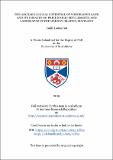The archaeological potential of windblown sand and its impacts on prehistoric settlements and landscapes in the Orkney Islands, Scotland
Abstract
This thesis comprises an investigation into the nature, chronology, and significance of prehistoric windblown sand deposition on archaeological sites in the Orkney Islands, Scotland. One of the most visible and frequently-encountered forms of evidence for dynamic coastal processes which took place over the last four millennia are horizons of calcareous (shell) and mineral (quartz and feldspar) sands, which were deposited in coastal landscapes and settlements by wind and wave dynamics. Around 20% of the Scottish coastline is made up of sand-based features, with the dune area comprising some 48,000ha (Dargie and Duncan 1999, 143).
Such coastal zones were densely settled in the prehistoric period. As monitoring of the modern coastline for changes affecting known archaeological sites continues, deposits of windblown sand - often interleaved with material evidence for human occupation – are becoming frequently recognised in the archaeological record. One coastal region which has felt the impacts of this coastal process (and continues to do so), is the Orkney archipelago, located off the northern coast of Mainland Scotland. It is this group of islands which form the geographical focus of this thesis. Previous archaeological interpretations of this important coastal process have been concerned with the development of chronologies of deposition in an attempt to tie the deposition of windblown sand to narratives of climatic deterioration. Such approaches fail to recognise the broader social significance of these windblown sand deposits, and how they were encountered by prehistorical inhabitants of the coastline. This thesis synthesises all known occurrences of windblown sand on archaeological sites in Orkney, and suggests additional ways in which their socio-economic significance can be realised.
Type
Thesis, PhD Doctor of Philosophy
Collections
Items in the St Andrews Research Repository are protected by copyright, with all rights reserved, unless otherwise indicated.

